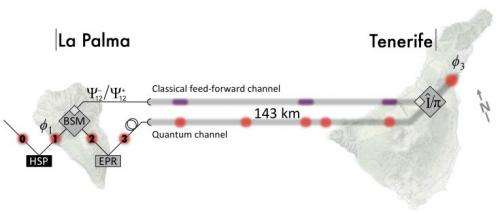June 1, 2012 report
European team bests Chinese record at teleporting distance (Corrected)

(Phys.org) -- A European team of physicists has bested the record set by a team of Chinese researchers last month for distance in teleporting quantum bits (qubits). Where the Chinese team accomplished their feat by teleporting photons across a lake, the European team did so by performing the same feat across the ocean between two islands off the coast of Africa. It was apparently no easy feat as the team describes in the paper they’ve written and uploaded to the preprint server arXiv; they had so much foul weather to contend with that their experiment took nearly a year to complete. The record breaking distance by the Chinese team was close to 100 kilometers. The Europeans bested that mark by almost fifty kilometers, setting up a possible rivalry between the two teams to see which might be the first to successfully teleport a qubit to an orbiting satellite.
The work done by both teams, and many others across the globe in working out how to use entanglement of quantum bits of information to achieve a degree of teleportation is not just an exercise to prove that physics theories are correct; if qubits can be sent and read onboard satellites a new age in such communications is likely to be born, one where messages can be sent without worry that they are being decoded by others. That’s because common sense tells researchers that information that is sent instantaneously, without having to actually travel through the air, leaves no means for those that might wish to capture such data.
In their paper, the team says that they had to develop several different techniques to deal with all the noise that occurs when attempting to communicate not just through the air, but air that is volatile. This was made even more difficult by uncooperative weather and sand storms. One of those new techniques might just help pave the way to teleporting qubits much longer distances. They used entangled photons to synchronize the clocks that were used on both ends of their system to enable them to look at the qubits at both locations at very nearly the same instant in time. Prior to the development of this method, researchers had to rely on GPS synchronization. This new method reduced the event window from 10 nanoseconds to just 3.
The team notes that adapting their technique to teleport qubits to a satellite should be easier in some respects, as there is less noise when trying to teleport straight up as opposed to horizontally through the atmosphere. Of course, there will be the problem of adjusting for the movement of a satellite relative to equipment on the ground, but thus far neither team seems to see that as a problem.
More information: Quantum teleportation using active feed-forward between two Canary Islands, arXiv:1205.3909v1 [quant-ph] arxiv.org/abs/1205.3909
Abstract
Quantum teleportation is a quintessential prerequisite of many quantum information processing protocols. By using quantum teleportation, one can circumvent the no-cloning theorem and faithfully transfer unknown quantum states to a party whose location is even unknown over arbitrary distances. Ever since the first experimental demonstrations of quantum teleportation of independent qubits and of squeezed states, researchers have progressively extended the communication distance in teleportation, usually without active feed-forward of the classical Bell-state measurement result which is an essential ingredient in future applications such as communication between quantum computers. Here we report the first long-distance quantum teleportation experiment with active feed-forward in real time. The experiment employed two optical links, quantum and classical, over 143 km free space between the two Canary Islands of La Palma and Tenerife. To achieve this, the experiment had to employ novel techniques such as a frequency-uncorrelated polarization-entangled photon pair source, ultra-low-noise single-photon detectors, and entanglement-assisted clock synchronization. The average teleported state fidelity was well beyond the classical limit of 2/3. Furthermore, we confirmed the quality of the quantum teleportation procedure (without feed-forward) by complete quantum process tomography. Our experiment confirms the maturity and applicability of the involved technologies in real-world scenarios, and is a milestone towards future satellite-based quantum teleportation.
Journal information: arXiv
© 2012 Phys.Org


















